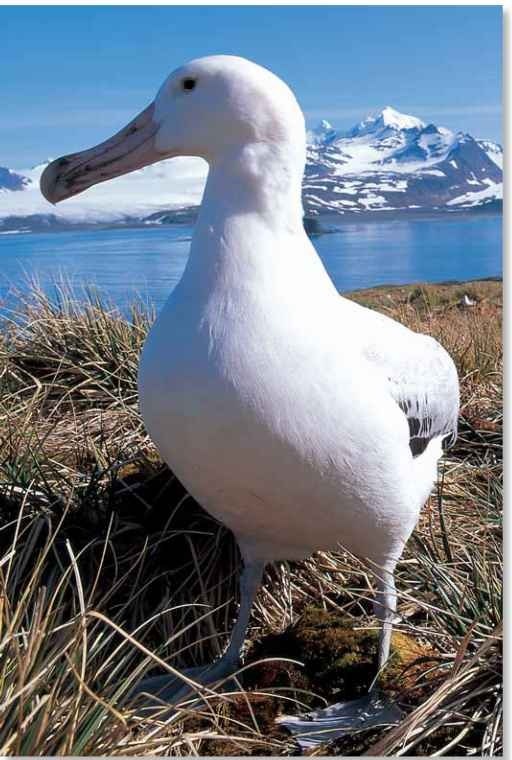ORDER
Procellariiformes
FAMILY
Diomedeidae
GENUS & SPECIES
KEY FEATURES
• One of the largest of all flying birds, with a wingspan of 12′
• Travels great distances at sea — thousands of miles a year in search of food
• Flies by gliding rather than flapping its wings
• Chick stays in the nest for nearly a year and may spend years at sea before breeding for the first time
WHERE IN THE WORLD?
Throughout oceans of southern Hemisphere; breeds on remote oceanic islands and island groups, which include Auckland island, south Georgia, Prince Edward island and the Crozet islands
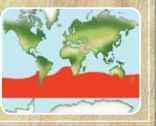
LIFECYCLE
The wandering albatross has no contenders to its mastery of the southern oceans’ winds. Flying for days on end, it searches for food in one of the most hostile environments.
HABITAT
The wandering albatross lives up to its name, spending most of the year far out at sea. This nomadic bird can be found soaring over vast expanses of often turbulent southern oceans that surround Antarctica. Occasionally, it lands on the water in calm weather to feed.With the breeding season in early spring, the albatross returns to land. On its remote, bleak and wind-blown island nesting site, the bird usually occupies a slope with only a scant covering of tussock grass. The nest site needs to offer proper exposure to the prevailing wind in order to make takeoffs and landings easier.
In from the sea The albatross may land on oceanic islands.
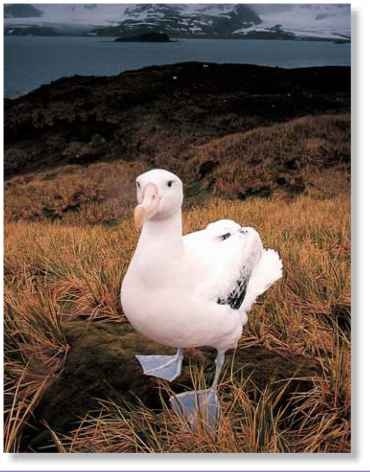
BEHAVIOR
To exploit the vast food resources of open southern oceans, the albatross needs to be very energy-efficient
in flight. Its long, heavy wings aren’t suitable for prolonged flapping. Instead, the bird takes advantage of variations in wind speed above the ocean’s surface to glide continuously without having to flap its wings — a process known as “dynamic soaring” or”slope gliding.”
The effective use of air currents comes at a cost. Because of its size and weight, the albatross needs a minimum wind speed of about I I mph to get airborne. In calm weather when the bird feeds on the ocean’s surface, it may become stranded for several days until the wind picks up again.
Blowing in the wind Thermal currents help the bird cross the ocean.
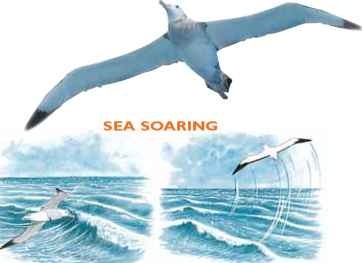
Losing speed…
Losing speed and height at the end of its glide path, the albatross seeks an up-current that billows in the trough between two waves.
Gaining height…
To gain height, the albatross turns into the wind and is lifted rapidly and almost vertically over the crest of the next wave.

Blown along…
At the higher altitude, the wind is strong and blows the albatross along at good speed. It then glides downwind as far as it can.
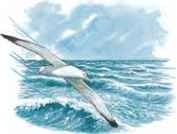
Again and again
This rise-and-fall sequence is repeated in long spirals, allowing the albatross to travel great distances merely by gliding.
• It’s believed that the word “albatross” is derived from a corruption of the Portuguese “alcatraz,” meaning large seabird.
• The albatross pairs
for life. Separation is likely to occur only if breeding attempts fail over a long period of time.
• The genus name Diomedea comes from Diomedes, the Greek hero of the Trojan War. In mythology, Diomedes’s dead warrior comrades were reincarnated as seabirds.
BREEDING -
Mature males are the first to return from the sea to their breeding colonies. While awaiting the arrival of their mates, they repair their old nests.The nests are bow-llike structures on the ground of mud and grass. Birds that haven’t mated before arrive fairly late in the breeding season to look for a mate. A courtship ritual then consists of a simple repertoire of displays, involving a series of ritual poses: “bill-circling,” “sky-pointing” and “flank-touching.”
Once the birds mate, they return to sea to feed and build body reserves. Both return to the nest just prior to the egg being laid and take turns incubating the egg until it hatches. One year after the egg was laid, the young albatross is fledged. Energy requirements for breeding on the cold islands are so high that breeding only takes place once every two years.
Remember me? Recognition displays reestablish pair bonds.
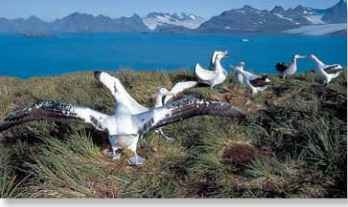
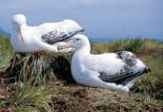
A It takes two On average, albatross mates relieve each other on the nest every week.
FOOD & FEEDING
Squid and octopus are the most important components of the albatross’s diet, but flying fish, pilchards and crustaceans are also taken. Squid perform vertical migrations in the sea, coming close to the surface at night and returning to deeper water in the day Consequently the albatross is usually more active at night when squid are easier to catch. Often, the albatross feeds at the ocean’s surface, but may plunge dive and up-end to reach prey.
Humans have accidentally helped the albatross’s survival. This bird frequently follows ships, especially fishing fleets, feeding on the edible refuse discarded by fishermen and the fish offal that’s dumped into the sea while the fish are processed. The wandering albatross’s powerful bill also allows it to tear at any floating carrion that it finds.
Open wide The chick is raised on a partly digested seafood mixed with a foul-smelling oil, which is regurgitated by the parents.
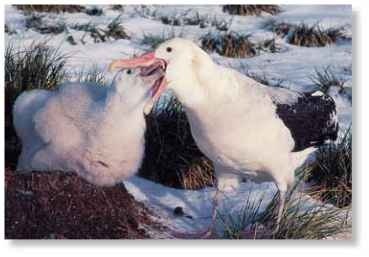
CONSERVATION
The wandering albatross isn’t under any severe threat but has undergone a considerable decline in the past.The present world population is about 21,000 breeding pairs, with some 80,000 nonbreeding birds remaining out at sea. Many birds have been reportedly killed by long-line fishing, which involves paying out a huge line of fish and squid hook baits. Albatrosses fly down to snatch the baits, become hooked, then drown as the main line sinks.
Profile
Wandering Albatross
The wandering albatross’s long, narrow wings and streamlined body are adaptations to a life of almost nonstop gliding over the ocean.
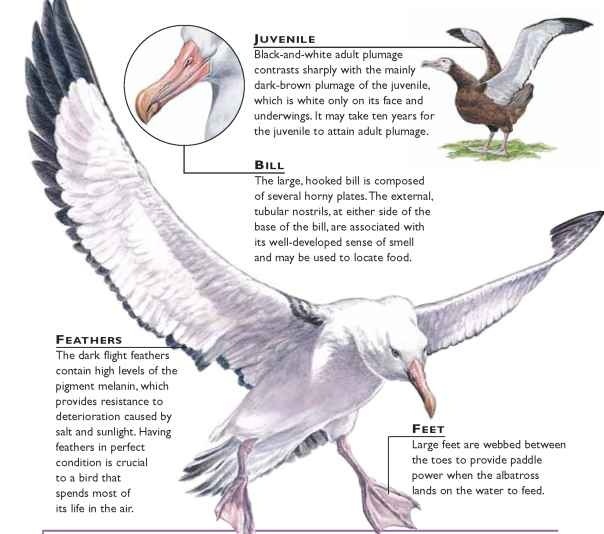
CREATURE COMPARISONS -
Waved and sooty albatrosses share with their larger relative the long, narrow wings of birds adapted to a life gliding over the oceans. Most albatross species are white with dark upperparts, wingtips, brow or tail; the waved albatross has a brown body and wings and yellowish tinge on its nape.The sooty albatross is almost completely chocolate-brown with a long, pointed tail.

| VITAL Weight |
‘STATISTICS 14-25 lbs. |
| Length | 3-5′ |
| Wingspan | 8-12′ |
| Sexual Maturity | 3-4 years |
| Mating Season | Early spring |
| Number of Eggs | 1 |
| Incubation Period | I 65-79 days |
| Fledging I Period | 39-40 weeks |
| Breeding Interval | Once every 2 years; nesting usually begins in November |
| Typical Diet | Squid, octopus, crustaceans, fish; ship refuse |
| Lifespan | 30-40 years; maybe 60 years |
RELATED SPECIES
• The 14 albatross species are divided into two genera: Diomedea (12 species) and Phoebetria (two species: sooty albatross and light-mantled sooty albatross). The wandering albatross and two other species — the royal and Amsterdam Island albatrosses — are often called the “great albatrosses.” The final nine smaller species in Diomedea are often called “mollymawks.”
